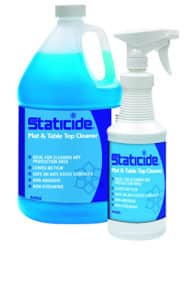Since dirt can behave as an insulator, it is important to regularly clean ESD mats before testing / monitoring the resistivity. Accumulated flux and residue creates a barrier on an ESD table mat, which inhibits the mat’s ESD properties. This barrier, in effect, restricts the mat from being able to quickly dissipate the charge of the component or product being worked on. Cleaning will also ensure optimum electrical performance and, by regularly cleaning, you will maintain the original resistivity of the anti-static mat whilst extending its shelf-life.
For ESD mats, we recommend using our Staticide Mat and Table Top Cleaner for optimum results. This non-abrasive formula is safe to use on workstations, table tops and anti-static mats, including rubber and vinyl. It is the ideal cleaner for areas in which static-sensitive devices are assembled, tested, and handled, but can also be used in areas that require a mild but effective cleaner. Mat & Table Top Cleaner is a non-flammable cleaner that leaves no film or streaks. It effectively removes flux residues, oily finger-marks, grease, nicotine, dirt, grime and inorganic contaminants. It also removes dirt on chair mats and other antistatic mats without degrading the surface’s antistatic properties.
How To Use Staticide Mat and Table Top Cleaner:
1) Apply liberally to the areas to be cleaned.
2) Wait 2-3 minutes to allow emulsifiers to penetrate.
3) Then wipe it off.
NEVER use alcohol or silicone-based products to clean an ESD mat. Alcohol will dry out the mat, while silicone will create an insulating barrier. Ultimately, both alcohol and silicone will corrode the mat’s ESD properties.
View our full range of ESD cleaning products by clicking here.
